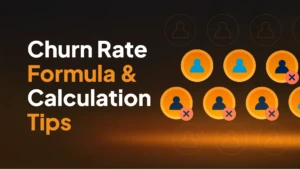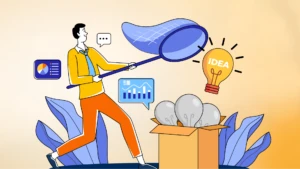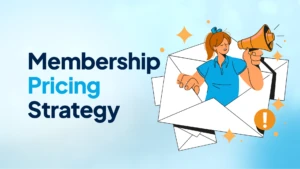In the membership business world, growth doesn’t just depend on acquiring new customers. It hinges on knowing how to reduce customer churn, i.e., keeping the ones you already have.
Every member who leaves represents more than lost revenue; it’s a potential advocate turned into a missed opportunity.
High churn rates can erode profitability, diminish brand credibility, and signal underlying service issues.
For 2025, with competition rising and consumer expectations shifting, mastering the art of reducing customer churn is essential.
By understanding why members leave and implementing strategic retention initiatives, you can safeguard your community, stabilize your income, and create long-term loyalty.
How to Reduce Customer Churn Rates: TL;DR
- Know the different types of churn so you can tailor your prevention strategies effectively.
- Identify at-risk members early by tracking engagement, usage patterns, and payment behavior.
- Deliver consistent value so members always see a reason to renew.
- Reward loyalty and engagement to strengthen emotional and financial commitment.
- Make every interaction seamless by removing friction and delivering exceptional support.
What Is Customer Churn?
What is churn in sales or other types of client-based business? Customer churn—also known as business churn or sales churn—refers to the percentage of customers who stop using your service within a given period.
In membership businesses, this typically shows up as cancellations, non-renewals, or accounts lapsing without renewal.
At its core, churn is more than a number; it’s a measure of how well you’re meeting your members’ needs.
A high churn rate suggests members aren’t finding enough ongoing value, while a low churn rate often reflects a well-aligned offering, strong engagement, and customer satisfaction.
Types of Customer Churning in Business
There are different ways a business can experience customer churn. Let’s take a look at the main types.
1. Voluntary Churn
Voluntary churn occurs when customers make a conscious decision to end their membership.
This often stems from dissatisfaction with the service, a belief that the value no longer justifies the price, or an attractive alternative offered by a competitor.
It can also be influenced by personal circumstances, such as changing priorities or reduced need for the service.
Because voluntary churn is an active choice, it’s critical to identify the root causes early and address them through improved engagement, better value propositions, and loyalty initiatives.
2. Involuntary Churn
Involuntary churn happens when a membership ends due to reasons outside the customer’s immediate intention, most often from failed payments or expired credit cards.
This form of churn can be particularly frustrating because the member may still want the service but loses access due to a technical or administrative issue.
Preventing involuntary churn requires proactive payment management, such as automated reminders, easy payment updates, and multiple billing attempts, to ensure that logistical errors don’t result in avoidable cancellations.
3. Active Churn
Active churn refers to situations where a customer directly communicates their intent to cancel.
This could happen after a specific incident that damaged the customer relationship or as the culmination of a gradual decline in perceived value.
Because active churn is deliberate, it presents an opportunity to intervene before the cancellation is finalized, for example, through personalized outreach, special offers, or targeted problem resolution.
4. Passive Churn
Passive churn occurs when members simply stop engaging with the service and allow their membership to lapse without formally canceling.
This type of churn can be harder to detect because there’s no explicit cancellation signal.
It often stems from declining usage, lack of perceived benefit, or other life priorities taking precedence.
Addressing passive churn requires monitoring engagement metrics, reactivating inactive members with targeted campaigns, and ensuring consistent reminders of the value they’re receiving.
5. Contractual Churn
Contractual churn takes place at predetermined renewal points, such as monthly, quarterly, or annual billing cycles.
Since these points are predictable, businesses have the advantage of preparing retention strategies well in advance.
Engaging members in the weeks leading up to renewal (through special offers, satisfaction check-ins, or service improvements) can significantly reduce the likelihood of losing them when the renewal date arrives.
6. Non-Contractual Churn
Non-contractual churn happens when members can cancel at any time without waiting for a specific renewal date.
This creates a constant risk of losing customers and requires continuous engagement to maintain loyalty.
In non-contractual models, it’s essential to provide ongoing value and maintain consistent communication so members always have a compelling reason to stay.
Causes of Customer Churn
There are various reasons why a business may experience customer churn.
1. Poor Customer Experience (CX)
One of the most common drivers of churn is a poor customer experience.
Long wait times, unresolved support tickets, and confusing processes can quickly frustrate members and make them feel undervalued.
In a competitive market, even minor service issues can push customers toward competitors.
Prioritizing responsive, empathetic, and streamlined support can help retain customers by making them feel heard and respected.
2. Pricing Concerns
If members feel the cost of a service outweighs its benefits, they are more likely to leave.
Pricing concerns may arise from actual financial strain, but they can also be the result of perceived value gaps where customers don’t recognize the full benefits they’re receiving.
Transparent pricing, clear communication of value, and offering different plan tiers can help address this challenge.
3. Competitor Influence
Even satisfied customers can be tempted away if a competitor offers more features, better service, or more attractive pricing.
Competitor influence is particularly strong in industries with low switching costs, where changing providers is quick and easy.
To counter this, businesses must continuously innovate, maintain strong relationships, and highlight their unique differentiators.
4. Lack of Engagement
When members don’t interact regularly with your service or community, they become more likely to leave.
A lack of engagement signals that they may not see ongoing value or that your offering isn’t top-of-mind in their daily lives.
Regular touchpoints, personalized content, and community-building initiatives can help increase engagement and strengthen customer loyalty.
5. Product/Service Misalignment
Sometimes churn happens because the product or service no longer aligns with the customer’s needs.
This can result from changes in the customer’s life circumstances, market trends, or evolving preferences.
Regularly gathering feedback and staying attuned to customer behavior helps ensure your offering evolves alongside their needs, reducing the risk of misalignment over time.
Why Mitigating and Preventing Customer Churn Is Important
Implementing churn mitigation, including customer churn reduction strategies, is vital for any subscription business. Here, we examine the key reasons for reducing the customer attrition rate.
1. Cost Savings
Acquiring a new customer is significantly more expensive than keeping an existing one, with estimates placing the cost at up to five times higher.
Retention efforts stretch your marketing and sales budgets further, ensuring that the investment you’ve already made in attracting a customer continues to yield returns.
By focusing on keeping current members satisfied and engaged, you’re not only reducing acquisition costs but also improving overall profitability.
This financial efficiency allows you to reallocate resources into product improvements, enhanced member experiences, and long-term growth strategies.
2. Revenue Stability
High churn creates unpredictable cash flow, making it difficult to plan ahead or invest confidently in your business.
When customers leave unexpectedly, recurring revenue streams suffer, and growth initiatives may stall.
Reducing churn brings greater predictability, allowing you to forecast earnings and set realistic goals.
Stable revenue also reassures stakeholders, investors, and partners that your business has a strong foundation and a clear growth trajectory.
3. Brand Reputation
Your current members are one of the most powerful marketing channels you have, but the reverse is also true; dissatisfied customers can harm your reputation quickly.
In the age of online reviews and social media, one negative experience can spread far beyond the individual customer.
Proactively managing churn means addressing dissatisfaction before it reaches the public stage.
By doing so, you not only retain more customers but also maintain a brand image that attracts new members through positive word of mouth and trust-building testimonials.
4. Growth Potential
Loyal customers are more than just repeat buyers; they are ambassadors for your brand.
They recommend your services to friends, family, and colleagues, often bringing in high-quality leads at no additional cost to you.
When churn is low, your member base becomes a fertile ground for organic growth, upsells, and cross-sells.
By building strong relationships and delivering consistent value, you create a community that grows not through aggressive marketing, but through genuine advocacy and shared satisfaction.
Reducing Customer Churn: 7 Proven Strategies
When considering how to reduce churn rate and increase retention, the most effective approach combines proactive member engagement with streamlined operational processes.
These strategies work together to strengthen relationships, reinforce value, and address potential issues before they cause cancellations.
So, how to reduce subscription churn? Here are seven proven strategies.
1. Improve Onboarding
The first days and weeks of a new member’s journey set the tone for their entire experience and increase your chance to avoid churn.
An effective onboarding process ensures that new members feel welcomed, informed, and confident about their decision to join.
This can include guided tutorials, personalized welcome messages, and quick-start resources that show them exactly how to get value from the service right away.
The faster a member experiences success and connection, the less likely they are to disengage.
2. Offer Personalized Engagement
Generic communication can make members feel like just another number.
By using data on member preferences, usage patterns, and behavior, you can create messages, offers, and experiences tailored to each individual.
This could be as simple as sending content recommendations based on past activity or offering discounts on services they’ve shown interest in.
Personalized engagement strengthens the emotional connection to your brand and makes members feel understood.
3. Reward Loyalty
Long-term members should be recognized and appreciated for their commitment.
Offering exclusive perks, early access to new features, or special discounts creates an incentive to remain part of your community and decrease churn.
Beyond monetary rewards, recognition through features like “Member Spotlights” or anniversary acknowledgments can deepen the sense of belonging.
When loyalty is rewarded, members see their continued participation as both valued and valuable.
4. Optimize Customer Support
Even the best services encounter issues from time to time, but the way you handle them can make or break member loyalty.
Fast, efficient, and empathetic customer support demonstrates that you take member concerns seriously.
Implementing multiple support channels, such as live chat, email, and phone, ensures members can reach you in the way that’s most convenient for them.
Proactive follow-up after resolving an issue further reassures members that their satisfaction matters.
5. Provide Ongoing Education
A member who understands how to get the most out of your service is far more likely to stay.
Ongoing education could include webinars, workshops, training videos, or regularly updated help guides.
This approach not only reinforces the value of your offering but also helps members discover new features or benefits they might not have been using.
An informed member is an engaged member, and engaged members are less likely to churn.
6. Conduct Regular Check-Ins
Waiting until a member is ready to cancel is too late.
By regularly checking in, whether through surveys, direct outreach, or automated satisfaction prompts, you can identify issues early.
These conversations can uncover dissatisfaction, confusion, or unmet needs that you can address before they escalate into cancellations.
Even short, friendly touchpoints can remind members that they are valued and heard.
7. Streamline Payment Processes
Many cancellations are caused not by dissatisfaction but by payment failures.
Automating payment reminders, such as a payment reminder email, offering multiple payment options, and making it simple to update billing information can significantly reduce this type of involuntary churn.
A smooth payment experience ensures that administrative errors don’t become customer losses.
This operational safeguard is one of the simplest but most effective ways to maintain retention rates.
Before It Happens: 5 Best Practices for Customer Churn Prevention
Along with other strategies, including knowing how to overcome objections in sales, learning how to prevent customer churn is about staying ahead of the problem rather than reacting to it after it occurs.
By anticipating member needs, addressing small issues before they grow, and creating an environment where loyalty naturally flourishes, you can build a stronger, more resilient customer base.
1. Know Your Ideal Member Persona
Understanding exactly who your service is designed for is the foundation of effective churn prevention.
A detailed member persona should go beyond basic demographics, incorporating motivations, challenges, and preferences.
When you know what your ideal members value most, you can tailor your offerings, messaging, and experiences to align with those needs.
This alignment not only attracts the right members but also keeps them engaged because they feel the service was built with them in mind.
2. Track Member Health Scores
Monitoring the “health” of each member relationship allows you to spot signs of potential churn before it happens.
Health scores can be based on metrics like logins, participation in events, feature usage, and payment reliability.
A declining score is an early warning that a member may be losing interest or encountering obstacles.
With this insight, you can reach out proactively, offering support, incentives, or guidance to re-engage them before they decide to leave.
3. Ask for Feedback Frequently
Regular feedback is a direct line to understanding how your members truly feel about their experience.
Surveys, polls, or informal check-ins provide valuable insights into what’s working and where improvements are needed.
The key is not just to collect this feedback but to act on it, demonstrating to members that their opinions lead to real changes.
This responsiveness builds trust and reinforces the idea that their voice matters, which strengthens loyalty over time.
4. Create Community Connections
Memberships built solely on transactional value are more vulnerable to churn than those that foster a sense of belonging.
By creating opportunities for members to connect with one another through online forums, in-person events, or social media groups, you transform your service into a community.
When members develop relationships and feel part of something larger than themselves, leaving becomes more than just canceling a subscription; it means losing a network and identity they value.
5. Test and Improve CX Continuously
Customer experience (CX) is never “finished.”
Even a well-designed process can become outdated or develop friction points over time.
By continuously testing and refining every aspect of the member journey from onboarding to billing, you ensure that interactions remain smooth and satisfying.
Small improvements, such as simplifying navigation or reducing response times, compound over time, making it easier for members to remain loyal without even thinking about it.
Manage Your Customer Churn and Retention With Member Solutions
At Member Solutions, we understand that preventing churn isn’t just about keeping numbers up; it’s about building a loyal, thriving member base.
Our platform offers the best membership management software, including automated payment reminders, robust engagement tools, and detailed analytics to help you monitor and improve retention.
By combining these tools with your expertise, you can create a membership experience that keeps people coming back year after year.
Key Takeaways
Reducing customer churn is essential for membership businesses to maintain profitability, brand reputation, and sustainable growth.
Success comes from understanding the causes and types of churn, then applying proactive strategies such as personalized engagement, loyalty rewards, and exceptional customer experiences.
Prevention depends on anticipating member needs, addressing issues early, and continuously improving the value you deliver.
By combining data-driven insights with consistent relationship-building, businesses can increase retention, strengthen loyalty, and create a thriving, long-term member base.
FAQs
How to calculate client churn risk?
Client churn risk can be calculated by tracking member activity, payment patterns, and engagement levels over time. A significant drop in usage or missed payments can indicate higher risk. Combining these metrics into a “health score” makes it easier to identify and address potential cancellations before they happen.
More advanced approaches include predictive analytics models that factor in customer demographics, purchase history, and service interactions. These tools allow businesses to act on early warning signs, tailoring interventions to the individual customer.
How to predict customer churn?
Customer churn can be predicted using behavioral analytics that identify patterns in member activity, feedback, and payment reliability. When members engage less, contact support more frequently, or reduce their purchases, they may be at risk. Predictive models help spot these trends early, so proactive action can be taken.
Machine learning tools can refine predictions by analyzing historical churn data alongside current behaviors. This allows you to anticipate churn more accurately and customize retention strategies for maximum impact.
Voluntary vs involuntary churn: What’s the difference?
Voluntary churn occurs when a customer actively chooses to cancel, typically due to dissatisfaction, pricing concerns, or the availability of better alternatives. Involuntary churn occurs when cancellations happen unintentionally, such as from failed payments or expired cards. Both require different strategies, from improving value to automating payment recovery.
For example, voluntary churn can be reduced through improved onboarding and loyalty rewards, while involuntary churn can often be addressed with automated billing reminders and seamless payment update processes.
Active vs passive churn: What’s the difference?
Active churn occurs when a customer takes deliberate steps to cancel their membership. Passive churn occurs when a customer stops engaging and allows their membership to lapse without direct communication. Addressing passive churn requires strong re-engagement strategies, while active churn often calls for targeted win-back campaigns.
Passive churn is often harder to detect because it lacks a clear cancellation signal, making regular engagement tracking crucial. Active churn presents an opportunity for intervention before the cancellation is finalized.
Contractual vs non-contractual churn: What’s the difference?
Contractual churn takes place at predetermined renewal points, such as monthly or annual billing cycles. Non-contractual churn can happen at any time, with no fixed renewal date. Understanding the difference helps you plan retention strategies, especially ahead of predictable contractual churn moments.
In contractual models, proactive outreach before renewals can dramatically improve retention rates. Non-contractual models require ongoing engagement to prevent cancellations at any moment.
What is a normal churn rate for SaaS businesses?
A typical monthly churn rate for SaaS businesses is around 3–5%, though this can vary widely by industry and target market. Lower churn generally indicates strong customer satisfaction and product-market fit, while higher churn suggests underlying retention challenges that need addressing.
High-growth SaaS companies often aim for churn rates below 3%, but this benchmark can shift based on business maturity, pricing models, and competitive landscapes.
What is the main reason for customer churn for membership businesses?
The most common reason for churn in membership businesses is a perceived lack of value. When members feel the service no longer meets their needs or is not worth the cost, they are more likely to leave, regardless of other factors like pricing or convenience.
This perception gap can be addressed through continuous engagement, regular value reminders, and evolving your offering to match member needs.
How to reduce subscriber churn?
Reducing subscriber churn requires consistent engagement, personalized communication, and loyalty incentives. Proactively reaching out to at-risk members and improving customer experience at every touchpoint keeps retention high. Education, community-building, and rewards programs all help members feel valued and committed.
Successful churn reduction strategies often involve blending automation with human interaction, ensuring efficiency without losing personal connection.
Can customer churn be negative?
Yes — negative churn occurs when revenue from existing customers grows through upsells, cross-sells, or expansions, outweighing the revenue lost from cancellations. In this scenario, overall customer value increases even if some members leave.
Negative churn is typically a sign of strong product value and successful expansion strategies.
Why is it called customer churn?
The term “customer churn” is a metaphor likening customer loss to liquid being churned out of a container. It represents the natural flow of customers leaving a business over time, highlighting the need to replace or retain them to maintain growth.
Over time, the phrase has become standard in business metrics, especially for subscription and membership-based models.




